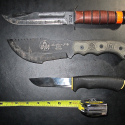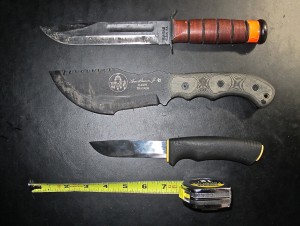The Survival Knife: Which One for You?

For anyone who spends time in the outdoors, arguably, one of the most important items to consider having with you is a knife. It can certainly be handy as an all-around tool, but, more to the point, it plays a vital role in your survival pack. After all, preparation is a key component to best responding to an acute emergency situation and a knife can help you more easily do 1,001 things. So, spending a little time considering which knife can best serve your personal tastes, your chosen outdoor activity, your potential needs, while not burning a hole in your wallet, can pay off huge dividends. Let me, then, offer you a few thoughts which you might find helpful to get your started.
- A survival knife isn’t just used for cutting. In a survival situation, you will most likely also be using your knife to pry, pound, chop, dig, scrap, and so forth. In fact, I would argue that actual cutting may only represent 20% tops of all the ways your knife will be used. For these reasons, I am a fan having at a least one “full tang” knife in my kit. Full tang means that the shank of the knife fully fits into the handle. As a practical matter, this means that, unlike a folding knife, the blade is far less likely to split from the handle when using it for ways other than cutting.
- A survival knife doesn’t need to be a huge knife. Okay, I admit, John Rambo’s knife looked darn impressive, but, like anything, looks can be deceiving. His knife wasn’t full tang (Do you remember the top of the handle that he unscrewed to reveal a storage area?), and for most of us it was too big to safely handle.
- A survival knife doesn’t need to cost a fortune. There are some excellent knives on the market which cost less than $50.
Based on these points, now let me present three knifes that, I believe, represent a nice spectrum of choices.
Since I am admittedly old-school and inherently distrustful of anything with lots of bells and whistles, considering a knife that has been literally “battle tested” for 70 plus years is a good place to start. The KA-BAR (photograph – top) was first issued to the US Marine Corps in 1942 and it is still used in many parts of the military today. This is a terrific baseline survival knife, and, at roughly $93 … even $20 less on some online stores … it is quite affordable.
Ever since I purchased the TOPS Tom Brown Tracker (photograph – middle) a few years ago, I remain conflicted. It is a great all-around knife and, though it may appear otherwise, it has a very simple and functional design. Plus, this knife is built like a tank … so when the Zombie Apocalypse comes, I’ll definitely be ready. But, truthfully, I rarely use this knife. It is too big and heavy for a survival kit, and at $299 it is too expensive to simply put into a kit to only periodically use.
Do you want to know what knife I most often recommend? On first look, the Mora Bushcraft 2010 (photograph – bottom) is probably the least impressive knife on the market. It’s blade is only 4″ long (the same as my folding knife), it is only 3/4 tang, the handle is a “high friction grip” (translation … plastic), and the sheath is super ugly. But this is the knife that I personally keep in my survival kit. While its overall use is a bit limited when compared to the KA-BAR, it is still quite functional and the blade is (trust me) surgical sharp. Also, it is light and very easy to pack. Moreover, the handle feels comfortable in smaller hands which, considering that roughly 60% of my students are women, is important. And at $44, this knife is quite affordable. In fact, the Bushcraft 2010 is the most expensive variant using this blade base — the other Mora variants range from $25-35. On top of these great qualities, this knife has an excellent pedigree — this blade has been standard issue to the Swedish Army infantry for almost 30 years.
Please keep in mind that this article is just an overview of what to consider when deciding on a knife. So, if you have any questions, please don’t hesitate to contact me at True North.
Meanwhile, check out our a recent video on this topic:


